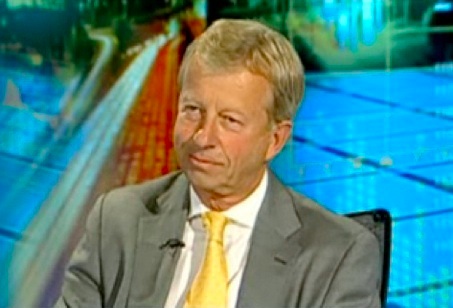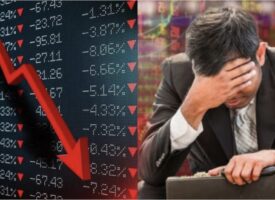Bank runs set to accelerate as fear and panic spreads and depositors worry their money will be frozen.
Disaster
March 12 (King World News) – Matthew Piepenburg, partner at Matterhorn Asset Management: The latest headlines, of course, are all pointing toward Silicon Valley Bank (SVB), and they should be.
This banking metaphor for the tech sector in particular and the previously described disaster in California as a whole, certainly deserves understanding and attention, provided below.
But once we get past a forensic look at the data and forces which killed SVB, we quickly discover that SVB is itself just a symbol of a much larger financial (and banking) crisis which ties together nearly all of the major macro forces which we’ve been tracking since Powell began his QT quest to be Volcker-reborn.
That is, we quickly discover that everything comes back to the Fed and bond market in general and the UST market in particular. But as I’ve argued for years, and will say again now: The bond market is the thing.
By the end of this brief report, we also discover that SVB is just the beginning; contagion inside and outside of the banking sector is about to get worse. Or stated more bluntly: “We aint seen nothing yet.”
But first, let’s look at the banks in Silicon Valley…
Listen to the greatest Egon von Greyerz audio interview ever
by CLICKING HERE OR ON THE IMAGE BELOW.
Two Failed Banks
The tech-friendly SVB story (i.e., FDIC shutdown) is actually preceded by another failed bank, namely the crypto-friendly Silvergate Capital. Corp, now heading into voluntary liquidation.
Because SVB was a much larger bank (>$170B in deposits) than Silvergate (>$6B in deposits), it got and deserved more headlines as the largest bank failure since well, the 2008 bank failures…
Unlike Lehman or Bear Stearns, the recent disasters at SVB and Silvergate were not the result of concentrated and levered bets/loans to crappy packaged credits, but rather the result of a good ol’ fashioned bank run wherein depositors all wanted to get their money out of the banks at the same time—a scenario of which I’ve warned for years and compared to a burning theater with an exit door the size of a mouse-hole.
Banks, of course, use and lever depositor funds to lend and invest at risk (which is why Henry Ford warned of revolution if folks actually understood what banks actually do). Thus, if a mass of depositors suddenly wants their money at the same time, it’s just not gonna be there.
So, why were depositors in a panic to exit?
It boils down to crypto fears, tech stress and bad banking practices.
No Silver Lining at Silvergate
At Silvergate, they provided loans to crypto enterprises, which were the belle of the speculation ball until Sam Bankman-Fried’s FTX implosion made investors weary of crypto exchanges. Nervous depositors withdrew billions of their crypto-linked deposits at the same time.
Silvergate, of course, didn’t have the billions needed when needed, because, well… banks by their operational (fractional reserve) nature never have the money when needed at the same time.
Thus, the bank had to quickly and desperately sell assets, which meant selling billions worth of non-mature Treasuries whose prices had tanked in the interim thanks to the Powell rate hikes.
See how the Fed lurks, head down and silent, behind every crisis?
This was selling bank assets at the worst time imaginable and immediately sent Silvergate into the red and toward the cold dark ocean floor.
Once DOJ investigations end and FDIC insurance runs out, we’ll discover just how “whole” the bigger depositors at Silvergate will be—but this will take time and end in some degree of pain for many of them.
Death Valley for Silicon Valley Bank
As for the bigger disaster at SVB, they mostly serviced start-ups and technology firms with a major focus on life sciences start-ups—i.e., yesterday’s unicorns and tomorrow’s donkeys.
These unicorns, of course, were not only under the cloud of the FTX fears in particular and falling faith in tech miracles in general, but equally under the pressure of Powell’s rate hikes, which made funding (or debt-rollovers) harder and more expensive to obtain for tech names.
In short, the keg party of easy money for questionable tech enterprises was beginning to unwind.
SVB’s slow and then rapid demise came as depositors (at the advice of their VC advisors) withdrew billions at the same time, which SVB (like Silvergate) could not match after selling UST assets at a massive loss to save the first withdrawals while burning the later movers.
In short, and like all Ponzi schemes, banks suffering a bank run can’t and won’t make everyone whole—just the first money out—i.e., the fastest runners in the burning theater.
Burn Victims, Recovery?
Banks, ironically, can’t technically go bank-rupt. Silvergate plans to eventually make all depositors whole as they sift through their assets in liquidation. Hmmm. Good luck with that.
SVB, however, waited too long for voluntary liquidation procedures and was instead taken over by the FDIC as a receiver to manage the sale of assets to return investor deposits as a dividend over time.
Furthermore, the FDIC “insures” investor deposits up to $250K, but that won’t help the vast majority of SVB deposits (95.5%) not covered by this so-called insurance.
The Contagion Effect?
Notwithstanding the pain felt by depositors at Silvergate and SVB, the fear there has spread to the broader banking sector (big bank to regional) which saw expected sell-offs at the end of last week and has prompted the inevitable question, namely: Is this another Lehman moment?
For now, we are talking about bank runs rather than banks failing ala 2008 due to massive derivate exposure and bad loans. In short, this is not (yet at least) a 2008-like banking crisis.
That said, and as we’ve reported countless times, post-2008 banks are still massively over-levered and over-exposed to that toxic waste dump otherwise known as the COMEX and derivative trade.
For now, however, those otherwise real (but ignored, buried and percolating) risks are not behind the current failures or current headlines at Silvergate or SVB.
Easy Prognosis
Based on context and current data, however, we can begin to make certain objective and early conclusions.
- Cash flow from VC into tech is about to get a lot tighter, as we’ve been warning for the last 2 years.
- SVB depositors may eventually get some or much of their money back over time once the bank’s assets (Treasuries, loans etc.) are sold off by the FDIC. Despite my very, very low opinion of bank regulators, at least SVB, unlike FTX, was regulated.
- As to a full-on crisis across all banks, it’s a bit early to say that the foregoing regional cancers will spread across all banks of all flavors, though our blunt reports on banking risk in the past suggest that banks as a whole are anything but safe. JP Morgan, for example, has $2.3T in deposits and a more diversified client base than the Silvergates and SVBs of the sector.
- Cryptos, already under the cloud of FTX and now SVB, will see more pain, as the sell-offs in this space last week confirm.
The Bigger, Scary Picture
Despite the still regional nature of the current banking crisis, we still see reasons to be concerned, very concerned, about systemic risk in the banking sector.
Banks, and banking practices, are complex little beasts. Just across town at that dying entity known as Credit Suisse, for example, they have been too afraid to even publicly report their cash-flow statements as the bank’s stock fell yet another 60%. So, yeah, things are complex…
But returning to the US in particular and banks in general, one can still derive the simple from the complex, which is the task of any good report.
Keep It Simple
At the most basic level, banks fail when the cost of funding their operations falls dramatically below the returns or yields on their performing/earning assets.
It is our view that such a set-up for further pain across the banking sector is real, a set-up made all the worse by—you guessed it—that entirely un-natural destroyer of natural markets forces, free price-discovery and honest capitalism otherwise known as the U.S. Federal Reserve.
Central Bankers and Broken Bonds
As I’ve written and spoken, everything is connected, and everything eventually take’s it signals from the bond market, which was long ago hijacked by the Fed.
Powell’s rate hikes, for example, don’t just occur in a vacuum to fight his bogus war on an inflation nightmare that he not too long ago promised was only “transitory.”
Fed QT and QE, for example, are more than just words, experiments or theories, they are un-natural, artificial and powerful toxins which can’t be contained to just making central bank balance sheets thinner or fatter and bogus CPI data higher and lower.
By raising the Fed Funds Rates toward 5% and above at rapid pace, Powell has done more than just make a tiny $300B dent in the Fed’s nearly $9T balance sheet. He has engineered a dis-inflationary recession and sent combined nominal returns in stocks AND bonds to levels not seen since 1871.
But when it comes to banking risk, Powell also just gut-punched that sector with unintended or at least grossly naive or criminally negligent force.
How so?
Even the Banks Can’t Fight the Fed?
Well, when the Fed raised rates, it sent bonds to the floor and hence yields to the moon (yields and bond price are inversely related). This impacts bank balance sheets.
Banks, who make a living by paying depositors at rate X while earning X+ are suddenly in a corner of the Fed’s own mis-design.
That is, the Fed has sent bond yields higher than the rates/yields which commercial banks offer depositors, which is why depositors are questioning the advantage of being, well…depositors.
This mis-match, of course, will require banks to raise depositor rates to compete with rising UST yields, a costly reality which cuts their profits and balance sheets.
Alternatively, banks could offer more bank shares to increase their capital, but this dilutes existing share counts and value, which is how bankers are paid.
To add insult to injury, banks (and bankers) are also facing the real risk of rising or at least persistent inflation, which simply means that the real return on even the more expensive bank depositor rates is ultimately a negative return when adjusted for the invisible tax of inflation.
All Conversations Return to Gold
So, no, we hardly think the commercial banking system, the massive and compounding risks of which we have reported for years, is anything remotely healthy, safe or credible.
All frowns and inevitable (yet increasingly empty) gold-bug critiques notwithstanding, we think holding a physical bar of segregated, allocated and non-levered gold in one’s own name in the world’s safest private vaults and jurisdictions makes a lot more sense than trusting your increasingly worthless paper or digital money to the world’s increasingly fractured banks, be they SVB, Credit Suisse or JP Morgan.
Just saying…Matthew Piepenburg’s powerful KWN audio interview has just been released and you can listen to it by CLICKING HERE OR ON THE IMAGE BELOW.
This will link you directly to more fantastic articles from Egon von Greyerz and Matthew Piepenburg CLICK HERE.
***To listen to Alasdair Macleod discuss the bank collapse, contagion and crisis as well as what this will mean for the gold market CLICK HERE OR ON THE IMAGE BELOW.
© 2023 by King World News®. All Rights Reserved. This material may not be published, broadcast, rewritten, or redistributed. However, linking directly to the articles is permitted and encouraged.













